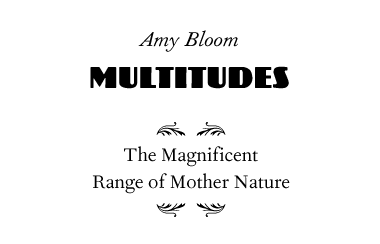
People who reveal (or announce) that their gender is variegated, rather than monochromatic or plainly colored in the current custom, have always presented difficulties. Not only is our society distressed by masculine women and feminine men and by the androgynous, even the big man who embroiders or the wife and mother of three who has a black belt in Tae Kwan Do, a buzz cut and no makeup in her gym bag stirs up a frisson of discomfort. Gender theorists love the gender-nonconforming as examples of all sorts of things, fundamentalists fear and despise them, and whether they avoid our gaze or deliberately seek to disturb, they are the handy punchline for every fading sit-com.
I sometimes think of our culture as like the Church in the days of Galileo. We will not see, and we will silence and mock, even banish and punish, those who say that what is, is. In one well-constructed study, only a third of all "normal" women (for the purposes of this particular study, that would be heterosexual women physically and mentally healthy by self- and clinical observers' reports) achieved a rating of "classically" feminine. This study described how people actually are – not what they wish to be, not how they imagine themselves to be, but simply how they are – and it made clear that few of us are what we have nonetheless agreed to believe our gender is. Our cultural standard of gender doesn't resemble gender as normal people – hetero and homo – experience it. The knife of normalcy cuts sharp and crazy in our culture, and like most trends and fancies, the craziness is only apparent in retrospect. Today we are appalled or amused by medieval or colonial or Victorian nonsense: surgeries for the sexually healthy woman, to make her less so; boarding school sodomy to make little boys into leaders of men; women forbidden to vote or wear pants or practice law; black people forbidden most everything; and white men forbidden fear and tears. I expect my grandchildren will look back on our ideas about gender and sexuality with much the same disbelief.
It's hard to dislodge cultural norms and myths when they provide such reassuring bulwarks in the face of such deep anxiety: the vote will make women barren; the sun moves around the earth. People did not conclude that the sun moved around the earth because they were stupid or narrow-minded; they believed it was so because it seemed reasonable, according to what they had heard or even seen, thus far; then it no longer seemed so evident, and by the time people faced that it was not so, the belief itself had come to seem necessary.
A great many people – sick of news from the margins, worn out by the sand shifting beneath their assumptions – like to imagine Nature as a sweet, simple voice: tulips in spring, Vermont's leaves falling in autumn. There are, of course, occasional mistakes – a leaf which doesn't fall, a clubfoot; our mistake is in thinking that the wide range of humanity represents aberration when in fact it represents just what it is: range. Nature is not two little notes on a child's flute; Nature is more like Aretha Franklin: vast, magnificent, capricious – occasionally hilarious – and infinitely varied. The platypus is not a mistake. The sex-changing animals, coral reef fish and Chinook salmon among them, are not mistakes; Nature offered us examples of protogyny and protandry long before transsexuals. The cactus and the blue potato are not mistakes. These plants and animals may not be as reassuring a sight as tulips are, but that doesn't make them deformities.
After several centuries of confusion, preceded by some early centuries of clarity (at least for Greek gentlemen), we seem to have gotten the difference between gender and sexuality reasonably clear: men are not defined primarily as creatures who only desire women, and sexual desire for men is not the thing that makes a person female. But in our post-Freudian, even post-Lacanian sophistication, in which we wink at the spinsters' "Boston marriage", now sure that it must have been a sexual relationship, however unacknowledged, and chuckle knowingly at the "man's man", aware that he is often just that, we seem baffled by the difference between sexuality and temperament, between one's sexual nature and one's personality. There is a whole history of fops and cowgirls, dandies with marcelled waves and tough, wisecracking broads, and where we once understood that one might be male, effeminate, and very heterosexual (all of Spencer Tracy's rivals for Katharine Hepburn come to mind), or female, masculine, and very heterosexual (Ethel Merman and Thelma Ritter), we seem to have now forgotten. The high-heeled, Chanel-clad lesbian and the football-playing, beer-swigging gay man puzzle us, as if, surely, some norm is violated when a woman who doesn't have sex with men likes lacy lingerie anyway, and a man who doesn't sleep with women still enjoys televised sports, cars, and sweatpants. In our collective cultural wish not to be out of it or old-fashioned, we've chosen to be simple-minded. We want to think that sexual orientation and personal style are one thing only and that anyone who suggests otherwise is trying to make a fool of us, or hide their shameful preference. Somehow, presented with a bouquet of possibilities, a wild assortment of gender, erotic preference, and the vast array of personalities, we throw most of it to the ground and insist that whatever it is, there can only be one and it should be the one we expect.
No one knows why the loss of the mother early in life leads some men to have extramarital affairs and others to crossdress. No one knows if transsexualism is a biological result or a mix of the biological, the psychological, and the cultural. (These things seem difficult to unravel, for me – as we are all born into a culture of one kind or another, I'm never quite clear how we strain it out of our assessments.) No one knows how well most transsexual people do ten or fifteen years after surgery, and no one knows how many transgendered people live happily, and syntonically, at ease with their gender and their sexuality, without ever going near a surgeon, an endocrinologist, or a psychiatrist.
There are men and women who devote themselves to the ins and outs of our private selves, our visions of self, the meaning of our public presentations, to our hidden histories and baffling communiques: psychiatrists, psychologists, social workers, sexologists and academics; they are joined in the field by political activists, surgeons, endocrinologists, entrepreneurs and lawyers, and all have their own agendas and their own notions of service. And just as their subjects and clients as customers owe them thanks for intelligent and useful assistance (when it is provided), our society as a whole owes rather more appreciation to the thousands of men and women who live their lives, tranquilly or in distress, with confidence or trepidation, as cactus and platypus, bearded lady and girlyboy, pushing all the rest of us to see Nature in full bloom, to see that Nature contains multitudes and although she makes mistakes, many of these people, examples of Nature's range, human creativity and gender's mutability, are not among them.
Back to Top | Table of Contents | Subscribe to Topic

|

